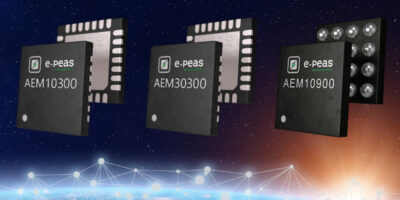As wearable, medical and smart sensor products use streamlined power management for energy harvesting hardware, e-peas has developed a family of battery charger devices, dedicated to charging. The company’s existing power management ICs (PMICs) offer direct power delivery to the application, as well as the charging of energy storage elements (such as Li-Ion batteries or super capacitors), but the AEM10900, AEM10300 and AEM30300 are fully dedicated to the charging function. This allows them to be used where a simpler implementation can be used and where there are space or cost constraints.
The PMICs achieve zero quiescent current draw from the battery. In other words, if energy harvesting stops for a prolonged period of time, the energy stored into the battery will not be wasted supplying the PMIC.
Working in conjunction with a single-cell photovoltaic panel, the integrated AEM10900 PMIC boost converter is optimised for solar-based energy harvesting implementations. It has a fast maximum power point tracking (MPPT) functionality designed for objects in movement. This allows the device to get the most energy from the ambient illumination available, storing as much as possible. It also has a 250mV cold start capability, which means it can commence with charging the battery even when light intensities are very low. AEM10900 introduces an I2C interface to minimise the pin count and to offer a larger set of potential configurations. The PMIC includes battery thermal protection, a joule counter to let the user know the amount of energy harvested, and a shipping mode in which the battery cannot be charged. The AEM10900 is suitable for wearable consumer products and body-worn medical monitoring equipment.
The AEM10300 and AEM30300 PMICs both have built-in low power DC/DC converters supporting operation over an input voltage range of 100mV to 4.5V. Adaptive energy management permits these devices to automatically switch between boost, buck-boost and buck operational configurations as deemed appropriate. This ensures that optimal energy transfer is always maintained between the respective inputs and the storage element.
The AEM10900, AEM10300 and AEM30300 battery chargers PMICs only require three external components, advises e-peas, for energy harvesting to be added while keeping the bill of materials costs low and taking up very little board space.
Geoffroy Gosset, CEO and co-founder of e-peas said: “Following on from in-depth consultations with our customer base, it became clear that having compact solutions for charging only was going to be of real value.”
The AEM10300 and AEM30300 PMICs are supplied in a 28-pin QFN package format, measuring 4.0 x 4.0mm and the AEM10900 is available in either the 28-pin QFN package or a 16-pin WLCSP (with 2.0 x 2.0mm dimensions).







